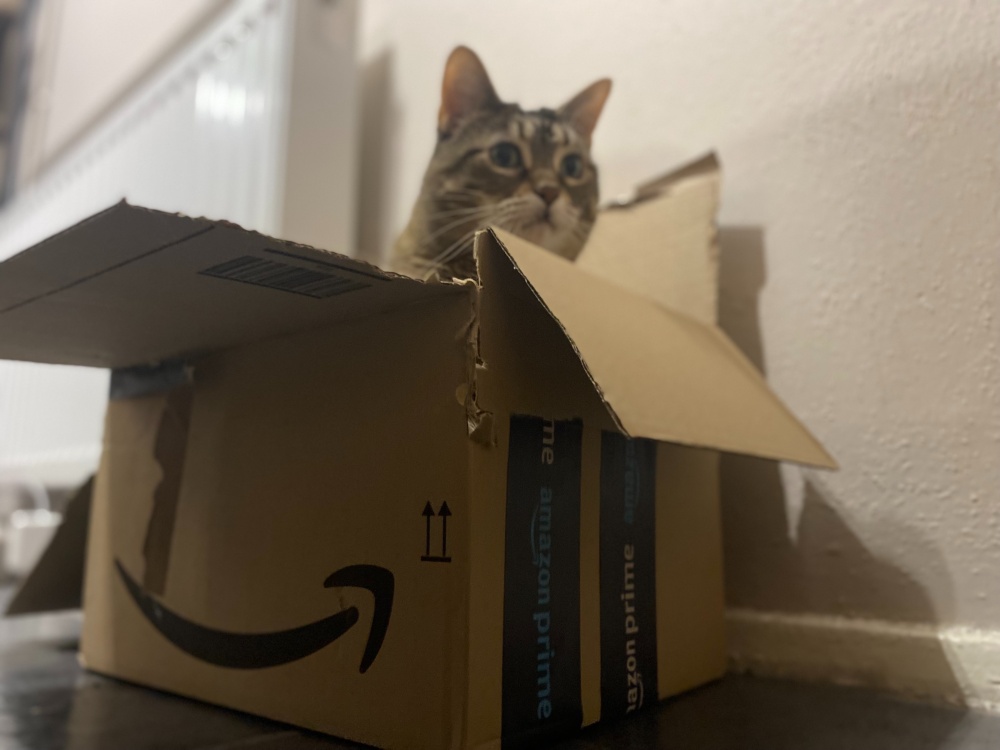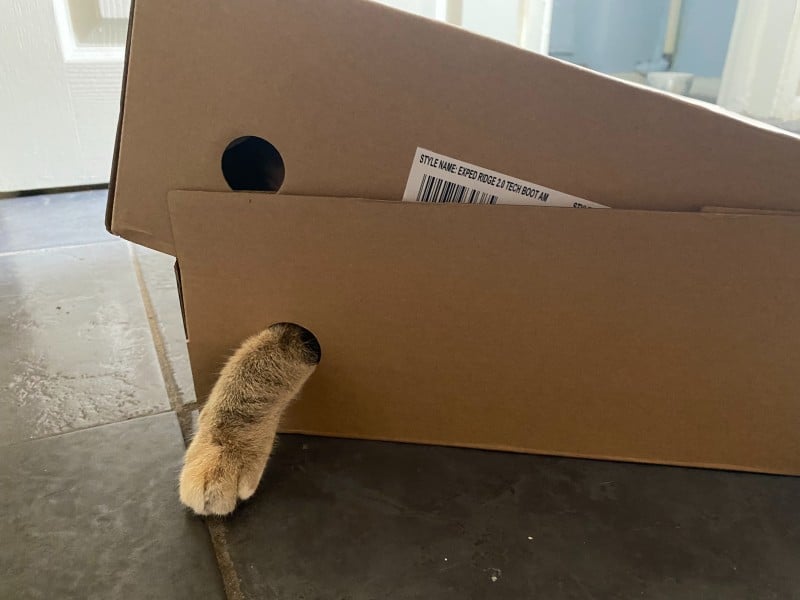- March 20, 2024
It’s Hip to Be Square: A Brief Look at Cats & Boxes of All Kinds

The information is current and up-to-date in accordance with the latest veterinarian research.
Hi, I’m Dr. Lauren! Read my introduction to learn more about me and my two adventurous cats, Pancake and Tiller.
It’s hip to be square, right?
But what about sitting in a square… is that also hip? Or potentially, even MORE hip?
Ask a cat, and the answer is likely to be a resounding YES.
But, why?
Social media loves a good post on the cat and the box. Compilations with such interesting titles include Cats vs Boxes…. Cats in Boxes Too Small, and even Big Cats Like Boxes Too, abound. The antics, the pure joy…but what is it that spurs this inexplicable behavior?
And as you dig deeper into trying to answer that question, you might also realize that cats aren’t just limited to boxes for fun. Cats that live indoors have a daily reliance on a box of a completely different type… and of course, there is the infamous Schroedinger’s cat and his infamous box. And for other cats, boxes provide a life-saving, stress-reducing receptacle.
So, just what is this feline fascination with the box? And how can you use a box to enrich your cat’s life?
Let’s take a deeper look.

Why Do Cats Love Boxes?
According to dictionary.com, a box is a container, case, or receptacle, that is usually rectangular, and made of various materials, often with a lid or removable cover.
So why do cats like boxes so much? Possibly, blame notable physicist Erwin Schröedinger, who inextricably linked cats with boxes, possibly perpetuating the mysterious link. Although modern science attests to the cat-box connection (a neat citizen science article found that cats will even sit in incomplete outlines of boxes), the jury still remains out on what the ultimate cause of said connection is. A fulfilment of the feline prey drive, allowing them to express hunting instincts is one theory. Another is that boxes provide support and a sense of safety.
For some cats, however, it doesn’t stop there. Litter boxes are both the godsend and the bane of many indoor cat owners. Unlike their cardboard brethren, these boxes often require careful selection (size is important! The bigger the better according to one study, though another found no significant preference in whether it was covered or uncovered, but rather just clean) and rumination on placement (not so simple as if it fits, I sits: litter boxes ideally should be in low-traffic areas of the house) culminating in either a tidy household or a headache worthy of veterinary attention and oodles of carpet cleaner. Yet, they are intricately linked to cats’ health.
For shelter cats, boxes can provide a significant reduction in stress levels, while they are awaiting adoption. Therefore, they are an invaluable, cost-effective tool for many shelter situations. Similarly, many veterinary practices also implement various box-like housing within their cat housing, to allow felines a more stress-free environment. (Tip: when looking for a new veterinary practice for your feline, look for add-ons like this in the boarding and hospital kennels for cats, and know that they are therefore more likely to be feline-focused!)
Make Your Cat Happy With Boxes!
How can you improve your box awareness, and enrich your own furry feline’s life through boxes? Here are a few tips:
- A litter box generally should be 1.5 times the length of your cat from head to butt- though bigger might be even better. For many North American cats, finding such a large box is often no easy task! Therefore, an easy, do-it-yourself, large litter box option is to buy a plastic storage container from a hardware store, and cut a u-shaped entrance into one side. Use sandpaper to take any rough edges away, and voila!
- Cardboard boxes of almost any size can make fantastic play zones for your cat. You can even order custom modular cat creations. Aldi (US supermarket) generally also puts out an inexpensive, holiday-themed cat cardboard house a few times a year, for the stylish feline in your life. Amazon and other delivery companies also often have boxes that are more than satisfactory for most felines. Just make sure to remove the tape or plastic (which is a foreign body hazard!) and any staples, prior to giving the box to your cat.
- You can spice up play time by cutting a hole into one side of the box, or even simply flipping it onto its side, or upside down, giving your cat even more ways to investigate and interact with the cardboard creation.
However you decide to tackle boxes and your cats’ enrichment–don’t get boxed in, or weighed down too much, on the approach you take. The lovely thing about boxes is that they are readily available, generally cheap, and most cats are happy for any and all sorts of box offerings. So, try something new: make a newer bigger litter box, find a new style of play box, or simply try putting their favorite box in a new spot to spice things up. And, go ahead, order that Amazon item you’ve been eyeing up. Your cat will thank you!
Tags
What do you think?
Related Articles

New Puppy Checklist: Gear You’ll Need for Your New Dog
Getting a new puppy is really exciting, but before you welcome them home, it’s important to prepare your space for them. Since puppies need a

How Big Do Mini Poodles Get? Vet Reviewed Average Weight & Growth Chart – Dogster
The information is current and up-to-date in accordance with the latest veterinarian research. Learn more » When you buy a Miniature Poodle, you might not

Can Police Dogs Smell Nicotine? Vet Verified Facts & Info – Dogster
The information is current and up-to-date in accordance with the latest veterinarian research. Learn more » While cigarette sales have been declining steadily for decades,

How Old Is 5 in Dog Years? Vet-Approved Guide to Each Size of Dog – Dogster
The information is current and up-to-date in accordance with the latest veterinarian research. Learn more » A common method for calculating a dog’s age is

